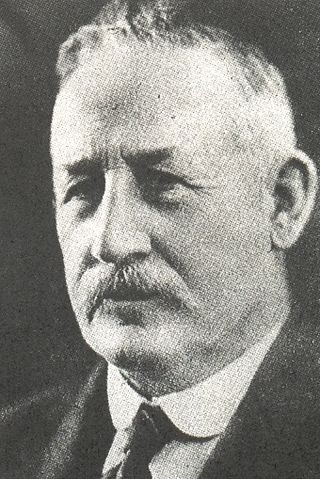
Kim John Carr is an Australian former politician who served as a Senator for Victoria between 1993 and 2022. Representing the Labor Party, he was a minister in the Rudd and Gillard governments.
The following lists events that happened during 1924 in Australia.

John Allan was an Australian politician who served as the 29th Premier of Victoria. He was born near Lancefield, where his father was a farmer of Scottish origin, and educated at state schools. He took up wheat and dairy farming at Wyuna and was director of a butter factory at Kyabram. In 1892 he married Annie Stewart, with whom he had six children.

In the Victorian political system, the State Minister for Housing is a State Government cabinet position responsible for Housing. The Minister for Housing is responsible for the Office of Housing ; and is one of six state ministers responsible for the Victorian Department of Families, Fairness and Housing (DFFH).

The Minister for Local Government in the Government of the Australian state of Victoria is the Minister responsible for supervising the activities of local government councils in the state, recommending allocation of grants to local governments for projects, assessing processes for redistributing municipal boundaries according to population, overseeing tendering processes for council services, airing any concerns of local governments at Cabinet meetings and co-ordinating council community and infrastructure work at a state level. The Minister achieves the Government's objectives through oversight of Local Government Victoria of the Department of Government Services.

The Treasurer of Victoria is the title held by the Cabinet Minister who is responsible for the financial management of the budget sector in the Australian state of Victoria. This primarily includes:

The Attorney-General of Victoria, in formal contexts also Attorney-General or Attorney General for Victoria, is a minister in the Government of Victoria, Australia. The Attorney-General is a senior minister in the state government and the First Law Officer of the State.
The First Dunstan Ministry was the 49th ministry of the Government of Victoria. It was led by the Premier of Victoria, Albert Dunstan. The ministry was sworn in on 2 April 1935, and was the first Country Party ministry in the history of Victoria.
The Prendergast Ministry was the 43rd ministry of the Government of Victoria. It was led by the Premier of Victoria, George Prendergast, of the Labor Party. The ministry was sworn in on 18 July 1924. On 12 November 1924, a motion of no-confidence in the Prendergast government was proposed in the Legislative Assembly by John Allan, leader of the Country Party—the motion was carried 34 votes to 28, defeating the government. Allan and his ministry were sworn in on 18 November.

The Hamer Ministry was the 59th ministry of the Government of Victoria. It was led by the Premier of Victoria, Rupert Hamer, of the Liberal Party. The ministry was sworn in on 24 August 1972.

The Kennett Ministry was the 64th ministry of the Government of Victoria. It was led by the Premier of Victoria, Jeff Kennett, of the Liberal Party. The ministry was sworn in on October 6, 1992, and remained a single ministry through two parliaments until on October 20, 1999.
The Cain II Ministry was the 62nd ministry of the Government of Victoria. It was led by the then Premier of Victoria, John Cain Jr., of the Australian Labor Party. The ministry was sworn in on April 8, 1982, and remained a single ministry through three parliaments until on August 10, 1990. The ministry dissolved upon Cain's resignation as Leader of the Labor Party.
The McPherson Ministry was the 46th ministry of the Government of Victoria. It was led by the Premier of Victoria, Sir William McPherson, and consisted of members of the Nationalist Party. The ministry was sworn in on 27 November 1928.
The Second Hogan Ministry was the 47th ministry of the Government of Victoria. It was led by the Premier of Victoria, Edmond Hogan, and consisted of members of the Labor Party. The ministry was sworn in on 12 December 1929.
The Argyle Ministry was the 48th ministry of the Government of Victoria. It was led by the Premier of Victoria, Stanley Argyle, and consisted of members of the United Australia Party (UAP) and the Country Party. The ministry was sworn in on 19 May 1932. On the 20th of March 1935, following the 1935 election, the Country party withdrew from the Coalition. Argyle then formed a new ministry of UAP members. The ministry was dissolved as a result of Argyle's resignation following defeat in the Legislative Assembly.
The Executive Council of Victoria, commonly referred to as the Cabinet of Victoria, oversees Victoria's executive branch of Government. Ministers of the cabinet undertake responsibilities inline with their portfolio area and are responsible for the subordinate government departments relevant to their ministry positions. The Governor of Victoria presides of the Executive council, however, is not a member.

The Minister for Agriculture is a minister within the Cabinet of Victoria tasked with the responsibility of overseeing the Victorian Government's agriculture initiatives. The minister is supported by the Department of Energy, Environment and Climate Action's Agriculture Victoria.
The Third Peacock Ministry was the 42nd ministry of the Government of Victoria. It was led by the Premier of Victoria, Sir Alexander Peacock, and consisted of members of the Nationalist Party. The ministry was sworn in on 28 April 1924 following Peacock becoming leader of the Nationalist Party after the collapse of the Nationalist-Country Coalition government led by Harry Lawson. The ministry dissolved following the Nationalist Party's loss at the 1924 state election and was succeeded by George Prendergast's Labor government.

The Minister of Forests was a former ministry portfolio within the Cabinet of Victoria.
The Lawson Ministry was the 41st ministry of the Government of Victoria. It was led by the Premier of Victoria, Harry Lawson, and consisted of members of the Nationalist Party. The ministry was sworn in on 21 March 1918 following the resignation of John Bowser's short lived ministry. In September 1923 Lawson formed a coalition government with the Country Party. However, this coalition only lasted until March 1924, after which Lawson formed a minority Nationalist government. Shortly afterward in 1924, Lawson's government was defeated and succeeded by new Nationalist Leader Sir Alexander Peacock's government.




